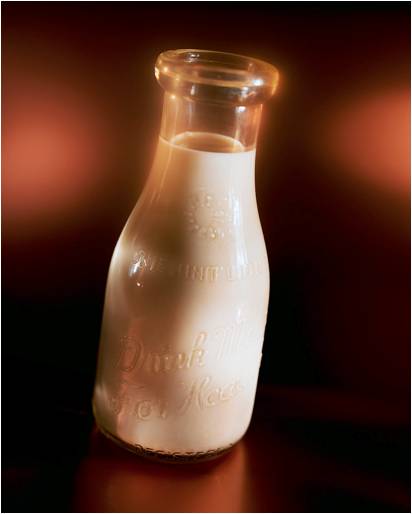
On the cart were huge silver steel cans and Maria would ladle the milk directly from them into our billy can, complete with its own lid. She came every day and I never thought about how many cows she might have had, or where they were housed. We lived in Big Bell, a gold mining town inland in Western Australia. It was hot. The earth was red and dusty. The milk was always creamy and white – and we never considered how Maria might tend her cows in that climate.
My mother cooked on a wood stove, cream and green with a Kookaburra on the door of the oven, and on the side hob she would bring the milk to a very gentle heat to scald it. We did not have a refrigerator. After an hour or so, the cream would rise to the top of the milk and in its wide, shallow enamel pan it would be allowed to cool. Clots of thick, scalded cream would set and be carefully drawn off with a slotted spoon. The milk poured into a big enamel jug and put into the ice chest – safe now from turning sour.
Sometimes we would have scones with jam and cream. Or just bread and jam and cream. Often the cream was taken to make desserts and we were left to drink the milk, thinner but still rich.
We had powdered milk, too. We didn’t like it much. Condensed milk, with a hole punched in each side of the lid so that the milk would run out into the coffee cup – thick and sweet – was highly prized. A suck on the tin; maybe another. Mum wouldn’t notice, we thought. Condensed milk tins emptied very quickly.
Later we got a kerosene refrigerator – smelly, smoky thing that it was – but it did give us better service than an ice chest or a coolgardie safe, dripping with water. My mother could make icecream in it – though I am afraid to say we were somewhat ungracious recipients of her hard work: for it had to be beaten furiously, partly frozen and then beaten again before the final freeze. Children of less than ten are not too mindful of their parents’ hard work – nor grateful for it, either.

Later, when we came to the city to live, the milkman still would deliver to the front door. At first, in big, shiny steel cans as Maria had done and you had to be there to meet him. He had been known to stop by your rainwater tank and give your billy can a little splash of water to make up the measure, if you left the can out on its own. Then, later, he brought the milk in glass bottles. A pint at a time. With bright gold caps and patterned ones for Christmas or Easter. His horse and cart clinked their way along the street, the milkman running from house to house, the horse quietly munching his feedback and walking along the road. He knew where to stop, when to start and whether to go around the corner. We had the little bottles at school, too.
Weetbix was our breakfast cereal of choice. Vitabrits went soggy too fast for my liking. If you were quick, you would get the milk bottle before your mother shook it and have one cup of top of milk on your breakfast – leaving the skinny milk for your crying brother or the cousins who had come to stay.
Recipe books routinely called for “one cup of top of milk”. Magpies learned to peck their way through the foil lids and drink a quarter of a cup of top of milk from the bottle before their beaks were not long enough to reach the remainder, if you did not get up early enough to bring in the milk. A rush of black and white feathers on the front verandah and the threat of a sharp beak sent many a small child back inside to get a broom.

I think of the beautiful black and white Holstein-Friesian cows in the South West of WA on the way to Margaret River. In their lush green pastures, making their long lines to the milking sheds each morning and night, their milk is collected daily from award winning herds of dairy cows. When I visited Margaret River, celebrating the “Cow Parade” last year, I like to think that they know I remember “one cup of top of milk” and I appreciate their gift.
About Snippets….
If you like our Snippets, join us online, and get regular updates of new postings.
Get started here, today. Stay up to date





I love your story telling abilities! I grew up on a cattle ranch in Montana. We had milk cows and they were treated as the queens of the place. I enjoyed milking them all but one she just was mean and knew how to use her tail or feet and hoof to hurt. Anyways, thank you for bringing home some memories for me.
Thank you Shawn and nice to hear of your own farming life. Dairy cows certainly have lots of personality and know how to make their point, that’s for sure. Thanks for the endorsement of our story telling too. I really appreciate that. 🙂
I miss the carts that used to come through our neighborhood when I was growing up. There was a produce man who brought his wares around in a horse-drawn cart, and no, I’m not very old. We lived in a Greek/Italian/Hungarian neighborhood in Ohio, and there were still a few gypsies in the area as late as 1976 or so.
My dad used to drive us all the way into Pennsylvania from Canton, Ohio to buy raw milk and fresh eggs. His lifelong wish was to have his own farm, a dream he had the privilege of fulfilling in a small way in the early 80’s, when he rented a portion of the Gaybrick farm near Mineral City, Ohio.
Hello Jack and thank you for sharing your memories, too. You are right – we still had horse and carts in the early 50’s – baker, milkman, iceman. It’s a bit scary sometimes to think about how much the world has changed and not always for the better. What I loved was the way the horses knew their route, where to stop and when to move on. One day, I must write about getting your fresh hot bread from the baker. Oh, that used to get us into so much trouble. 🙂